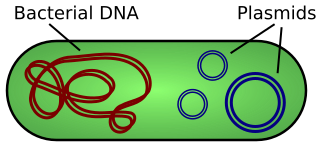Plasmid
A plasmid is a small, circularly coiled stretch of DNA found loose in the cytoplasm of bacteria. It exists in multiple copies (10–50) that carry one or more genes. Their replication occurs independently of the main chromosome.
Plasmids are variable and carry hereditary information outside the nucleus. They have the ability to move from cell to cell. It is a transfer to the cytoplasm of other bacteria, most often through conjugation (F+ factor, i.e., sex factor of E.coli). After opening the circular structure, they can incorporate into the main chromosome. During conjugation, the duplicate opens its ring usually at a fixed location, where we assume the genes for plasmid transfer to be located.
Plasmids carry certain information that is not strictly necessary for survival. Medically important is that they contain genes for antibiotic resistance and Sulfonamide resistance and thus gain resistance to these agents (RTF = resistance transfer factor). They also contain genes that affect the pathogenicity of bacteria.
Plasmids are important for research in Genetic engineering.
Links[edit | edit source]
Related articles[edit | edit source]
- Gene manipulation and genetic engineering
- Biochemistry of genetic engineering
- Genetic modification
- Amplification and expression of an isolated gene in a host cell
- Recombinant DNA
- Gene therapy
- Parasexual events in bacteria
External links[edit | edit source]
Source[edit | edit source]
- OTOVÁ, Berta. Lékařská biologie a genetika : 1.díl. Praha 2008 edition. Nakladatelství karolinum, 2008. ISBN 978-80-246-1594-3.
- Jan Jelínek, Vladimír Zicháček. . Biologie pro gymnázia : (teoretická a praktická část). - edition. 2014. 579 pp. ISBN 9788071823384.



